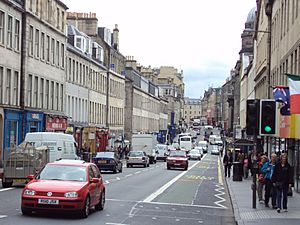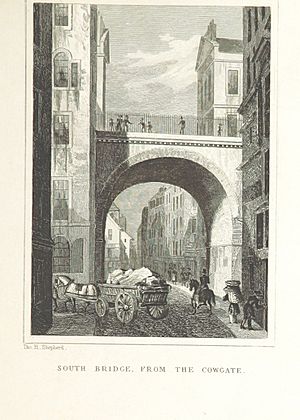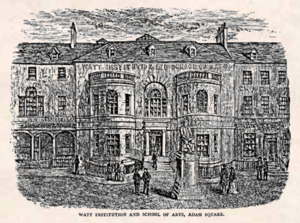South Bridge, Edinburgh facts for kids
The South Bridge is a major road and street in Edinburgh, Scotland. It connects the historic High Street in the north to Nicolson Street in the south. This important bridge helps people travel over a deep valley called the Cowgate, which runs through the city. The South Bridge dips down to cross the Cowgate, then rises back up towards Nicolson Street.
Contents
Building the South Bridge
Why a New Bridge Was Needed
In 1784, a man named James Hunter Blair, who was the Lord Provost of Edinburgh (like a mayor), suggested building the South Bridge. There was already a North Bridge connecting Edinburgh's Old Town to its New Town. The South Bridge was planned to extend this connection further south. It would make it much easier to travel to the areas south of the city, especially by crossing over the Cowgate valley. To build the bridge, some old buildings, including the city's poultry market, had to be removed.
Who Designed and Built It?
The design for the South Bridge was created by Robert Kay. The actual construction work was carried out by Alexander Laing.
Starting the Construction
The plan to build the South Bridge became official when the South Bridge Act 1785 was passed in 1785. Money was raised through taxes to pay for the project. The famous architect Robert Adam also helped with the plans. The first stone of the bridge was laid on August 1, 1785, by George Gordon, Lord Haddo.
Opening the Bridge
Even before it was fully finished, the bridge was opened for people to walk across on November 19, 1786. They used wooden planks laid over the completed arches. The entire bridge was finally finished and opened in 1788.
What Makes South Bridge Special?
Hidden Arches and Vaults
The South Bridge is made up of nineteen arches. However, you can only see one large arch from the outside, where the bridge crosses over the Cowgate street. This is because buildings were built very close to both sides of the bridge, hiding most of its structure.
Below the street level of the bridge, there are many hidden buildings and vaults. These vaults are now a popular tourist attraction known as the Edinburgh Vaults. Many of the buildings on the bridge's street level also have separate entrances from the streets below, like the Cowgate, or from parallel streets like Niddry Street and Blair Street.
Adam Square and Changes Over Time
An older area called Adam Square was once part of the South Bridge streetscape. It was built around 1770 and was located at the southwest end of the bridge. This area was later rebuilt twice, starting around 1870, to make way for Chambers Street.
In 2002, a big fire known as the "Cowgate Fire" destroyed some of the original buildings in the southwest part of the bridge area. This section has since been rebuilt and now includes a hotel and a supermarket.
Goldsmiths Hall
Inside the historic structure of the South Bridge, there is a very important room called Goldsmiths Hall. This room is linked to the old trade guilds (groups of skilled workers). It's located at the attic level and cannot be seen from the outside. Today, you can only reach it through a hallway from Blair Street.
How the Name Changed
Early maps, like one from 1804 by John Ainslie, showed the street name as "South Bridge Street." However, by the 1850s, the name was shortened to simply "South Bridge," which is what we call it today.




